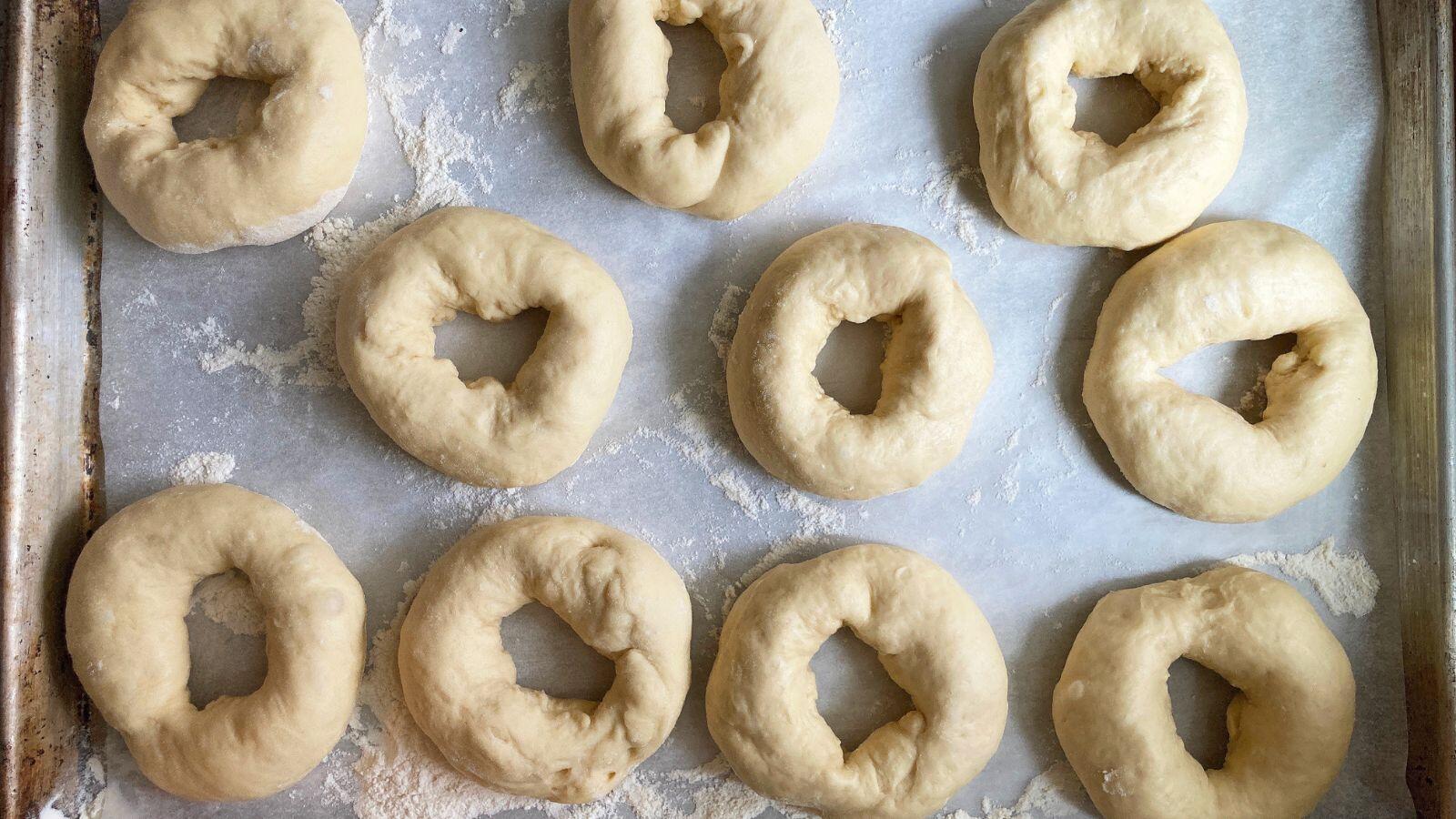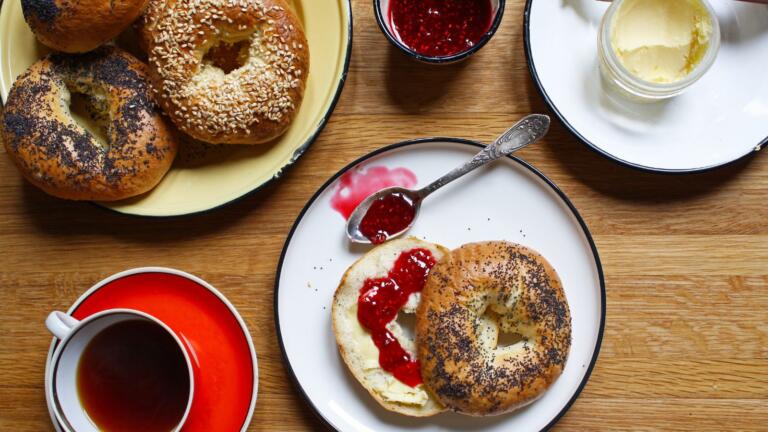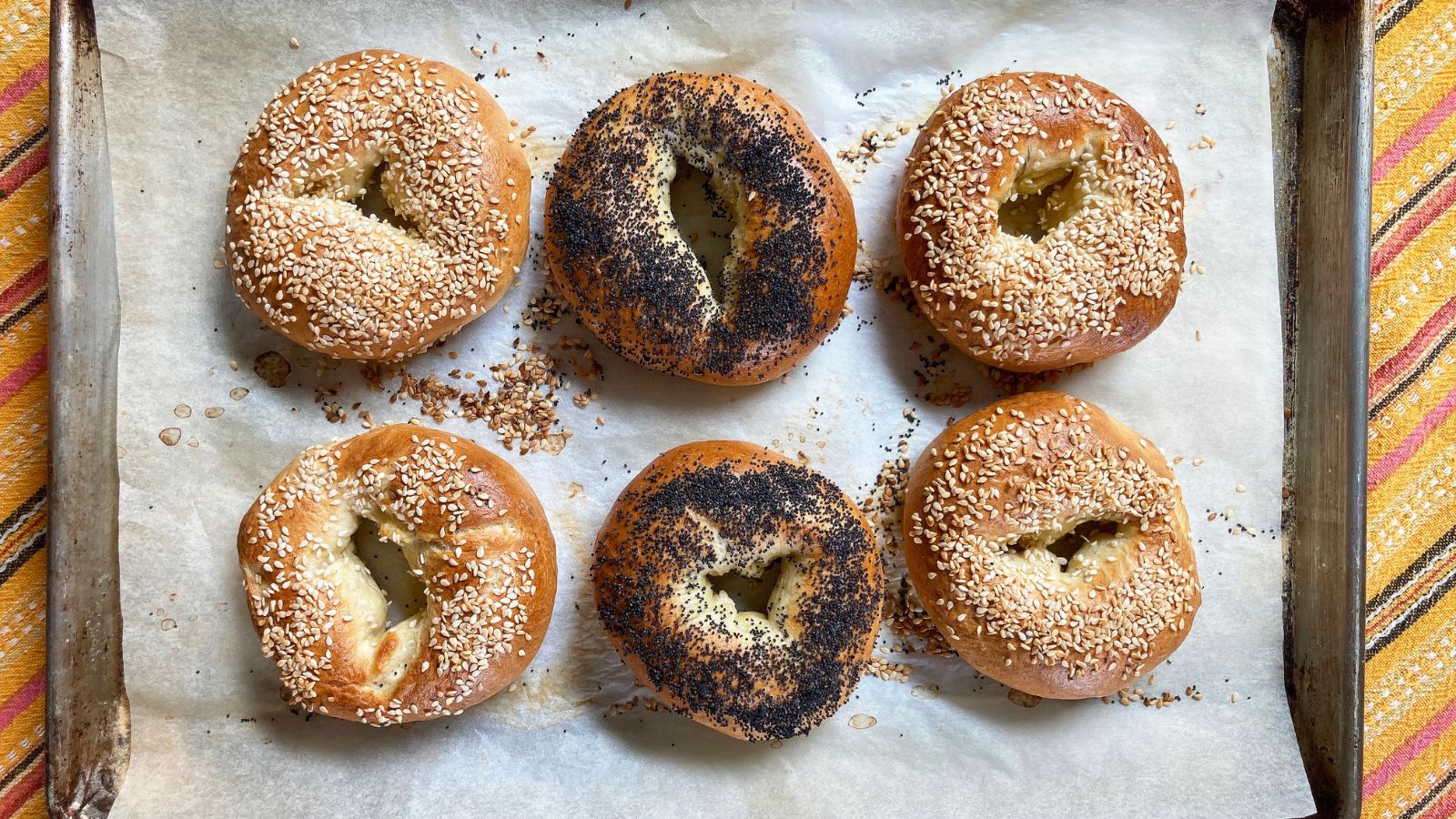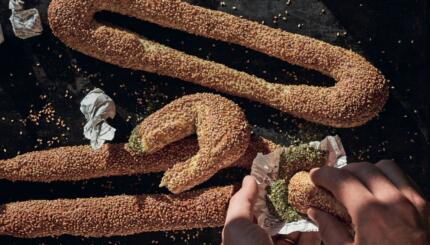Bublik looks a lot like a bagel, sounds a little like a bagel, but is not quite a bagel. Bublik (pronounced boob-leek) or bubliki (plural), is the Ukrainian version of a yeasted, boiled and rounded bread that dates back to 18th century Odessa. Just like New York or Montreal-style bagels, bubliki came to Ukraine by way of Ashkenazi Jewish immigrants from Poland and Eastern Europe, later becoming popular throughout the former Soviet Union. While bread shaped into rings dates back to the 13th century, written records of the beygl (Yiddish for bagel), date back to 1610 in Krakow, Poland, where bagels were mentioned in Jewish community ordinances. The word bublik comes from the proto-Slavic word boubl, which means swelling or bubble. These delicious rings of bread are also affectionately called bublichki, and there is even a famous Yiddish-Ukrainain song from the 1920’s with this diminutive name.
Popular across the former Soviet Union, bubliki are traditionally served with tea and topped with butter, jam or smetana (sour cream). Compared to bagels, bubliki have a tender crust, are a little sweeter and sometimes have a larger hole in their center. The chewiness of the bublik varies by baker, but they’re most often lighter than their New York counterparts. While bagels are made with a simple dough of yeasted flour and water, bubliki are typically made with an enriched yeasted dough that includes butter, egg and milk. While bagels and bubliki are both boiled in water before being baked (giving them their unmistakable glossy crust), bagels are traditionally boiled in water with barley malt syrup added to it, whereas bubliki are boiled in plain water. In some ways, the flavor of bubliki is closer to a Montreal-style bagel, which is sweetened and boiled with honey.
In all its forms, bubliki and bagels have made their way into kitchens and bakeries around the world. While it takes time to make bubliki from scratch, you will be rewarded with the incomparable joy of eating a fresh, warm bublik, and your home will be filled with the smell of one of the most comforting Jewish breads.
Note: Bubliki are best eaten the same day they are made, but they also freeze well, and can be reheated in an oven or toaster.
The Nosher celebrates the traditions and recipes that have brought Jews together for centuries. Donate today to keep The Nosher's stories and recipes accessible to all.

Bubliki
Try this sweet bagel-alternative with your afternoon tea.
- Total Time: 45 minutes
- Yield: 10
Ingredients
- 1 ½ cups (350 ml) milk (or non-dairy, unsweetened milk)
- 2 ¼ tsp (7g/1 packet) active dry yeast
- 2 Tbsps sugar
- 4 cups (525 g) bread flour, or all purpose flour
- 4 Tbsp (65 g) unsalted butter or vegan butter, melted
- 1 large egg
- 2 Tbsp honey
- 2 tsp kosher salt or 1 ½ tsp sea salt
- poppy seeds or sesame seeds (optional)
Instructions
- Heat the milk until it is just warm, between 80-100°F.
-
Add the active dry yeast and sugar to the milk and stir. Let the yeast proof for 5-10 minutes, or until it is foamy on top.
- In a large bowl, or in the bowl of a stand mixer with the dough hook attachment, add the flour, melted butter, egg, honey and salt. Add the milk and yeast mixture to the bowl. Combine the dough together by hand, or use the mixer on low. Mix until it forms a craggy ball. If kneading by hand, transfer the dough onto a clean surface and knead until the dough is smooth, elastic and firm, about 10-15 minutes. If using a stand mixer, increase the speed to medium and knead for 8-10 minutes.
- Check to see if enough gluten has formed by doing the window pain test: rip off a small piece of dough, and gently stretch it until it is thin enough that you can see light coming through it. If it starts to tear before you can stretch it thin, then continue to knead the dough for a few more minutes, and test it again.
- Transfer the dough to a large lightly oiled bowl and cover it tightly with plastic wrap or a lid. Refrigerate the dough overnight, or for at last 8 hours. It is ideal to let this dough slowly proof in the fridge, but alternatively, you can cover the bowl with a damp towel and allow the dough to rise at room temperature for 1.5-2 hours, or until doubled in size.
- Remove the proved dough from the fridge and let it sit at room temperature for 30 minutes. Transfer the dough onto a clean surface, and press it down to fully deflate any bubbles in the dough.
- For even-sized bubliki, weigh the dough, and divide the total amount by 10. Each bublik should weigh 1/10th of the total weight of dough (or roughly 90g per bublik). If you do not have a scale, divide the dough into 10 approximately equal-sized pieces.
- Line a baking sheet with a Silpat or parchment paper, and lightly sprinkle the surface with flour.
- Make 10 balls of dough by taking each piece of dough, and pinching the edges of the dough towards the center to form a ball. Roll the balls of dough and place them a few inches apart from each other on the lined baking sheet.
- Loosely cover the balls of dough with plastic wrap, and allow them to rise for 15 minutes.
- After 15 minutes, shape each ball of dough into a bublik by sticking your thumb down into the center of the dough, forming a hole, and then using both hands to stretch it into a ring about 5-6 inches in diameter (it will quickly shrink back a bit when you place it back onto the lined parchment paper).
- Cover all of the formed bubliki with the loose plastic wrap and allow them to rise for another 20 minutes.
- While the bubliki are rising, preheat the oven to 500°F and arrange the baking racks on the upper and lower thirds of the oven.
- Line two more baking sheets with parchment paper.
- Once the water is boiling and the bubliki have risen, add 2-3 at a time to the boiling water (be careful not to crowd the pot). Let the bubliki boil for 30 seconds on one side, then flip them and let them boil for 30 seconds on the opposite side. Transfer the bubliki to the parchment-lined baking sheets, leaving several inches of room between each bublik, about 4-6 bubliki per baking sheet. If topping with seeds, immediately sprinkle poppy or sesame seeds over each bublik.
- Place one baking sheet on the top third of the oven, and one baking sheet on the lower third. Immediately lower the oven temperature to 450°F. Bake for 5-6 minutes, then rotate the baking sheets and bake for an additional 5-7 minutes or until deep golden brown on the top and the bottom of each bublik.
- Allow the bubliki to cool on a baking rack. Serve warm or at room temperature.
Notes
- Bubliki are best eaten the same day they are made, but they also freeze well, and can be reheated in an oven or toaster.
- Prep Time: 30 minutes
- Cook Time: 10-15 minutes
- Category: Breakfast
- Method: Baking
- Cuisine: Ukranian




Bagels sound fantastic, can you email me the recipe?
Thanks
Hi Roberta, here’s our recipe for New York-style bagels. It is also linked in the article. Enjoy!
Sounds great…..planning on making these
this coming weekend….can,t wait
My wife and I travelled to Greece this fall and were surprised to have Greek bagels (called koulouri Thessalonikis) at the hotel as we enjoyed our first breakfast. We are ex Montrealers and found them similar in taste to Montreal bagels but not in shape. It is an energy food in Greece and street vendors sell them in numerous locations. Thessalonikis or Salonika was home to a large Jewish community many years ago and it was situated in Turkey during the Ottoman rule (from the 15th Century) and and later Greece (1912)
This recipe sounds terrific. Can’t wait. Have you guys ever heard of something called bubbalah? My grandma used to make it in a 11″ deep skillett, on the stove. It was served with sugar sprinkled on it.
They look smaller and less puffed out than most bagels that are available today. In Paterson, NJ, the Hamilton Ave Bakery baked bagels that look like the ones shown in your article. Sam “Bake” Cohen and his wife Babe ran the bakery and people lined up on Saturday nights to get a dozen to take home for Sunday morning. Only plain and poppy seed, but were they ever good.
Ask anyone from Paterson and they will immediately tell you about this place.
Bake and Babe died and took the recipe with them.
I’ve read that parchment paper should not be used in the oven with temperatures higher than 420• Fahrenheit.